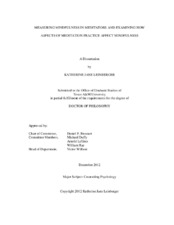| dc.description.abstract | Mindfulness is an element of consciousness which has historically been associated with well-being. Mindfulness-based clinical interventions intend on reducing cognitive vulnerability to emotional distress and have produced promising results. Such endeavors however rest upon the dissent that remains among researchers on how to operationally define the construct. Measuring mindfulness in a valid and reliable manner is an essential part of scientific inquiry and facilitates the effort to define the construct. This study examines three newer self-report mindfulness instruments; Five Facet Mindfulness Questionnaire (FFMQ), the Toronto Mindfulness Scale (TMS) and the Experiences Questionnaire (EQ). A sample of non-meditators (Texas A&M University students; n =141) and meditators (non-clinical population from Bay Area, California; n =157) with a wide range of meditation experience completed the instruments. Multiple correlations allowed for an in-depth examination of the measures at full-scale and sub-scale level and all yielded significant and positive relations. Regression analyses established that meditation does increase mindfulness scores as measured by the FFMQ, TMS and EQ. Sub-scales FFMQ Observe, FFMQ Non React and TMS Decenter increased most of the combined eight facets; while FFMQ Describe and FFMQ Aware increased least. Lastly, the study examined how various aspects of meditation practice affect total mindfulness. Aspects of practice included: Number of sittings per week (sit/wk); time spent per meditation sitting (time/med); how long the participant has engaged in formal meditation (how long) and style of meditation (style). Meditation styles were grouped into the following categories; 1) Mindfulness, Vipassana, Zen and Shambhala; 2) Concentration and Transcendental; 3) Blend and 4) “I don’t know”. “Sit/wk”, “how long” and “style” were predictive of total mindfulness, with “how long” being the strongest predictor. All the mindfulness facets were predicted by meditation style except for FFMQ Observe, FFMQ Describe and TMS Curiosity. Meditation styles mindfulness, Vipassana, Zen and Shambhala were associated with the highest mindfulness scores. | en |


